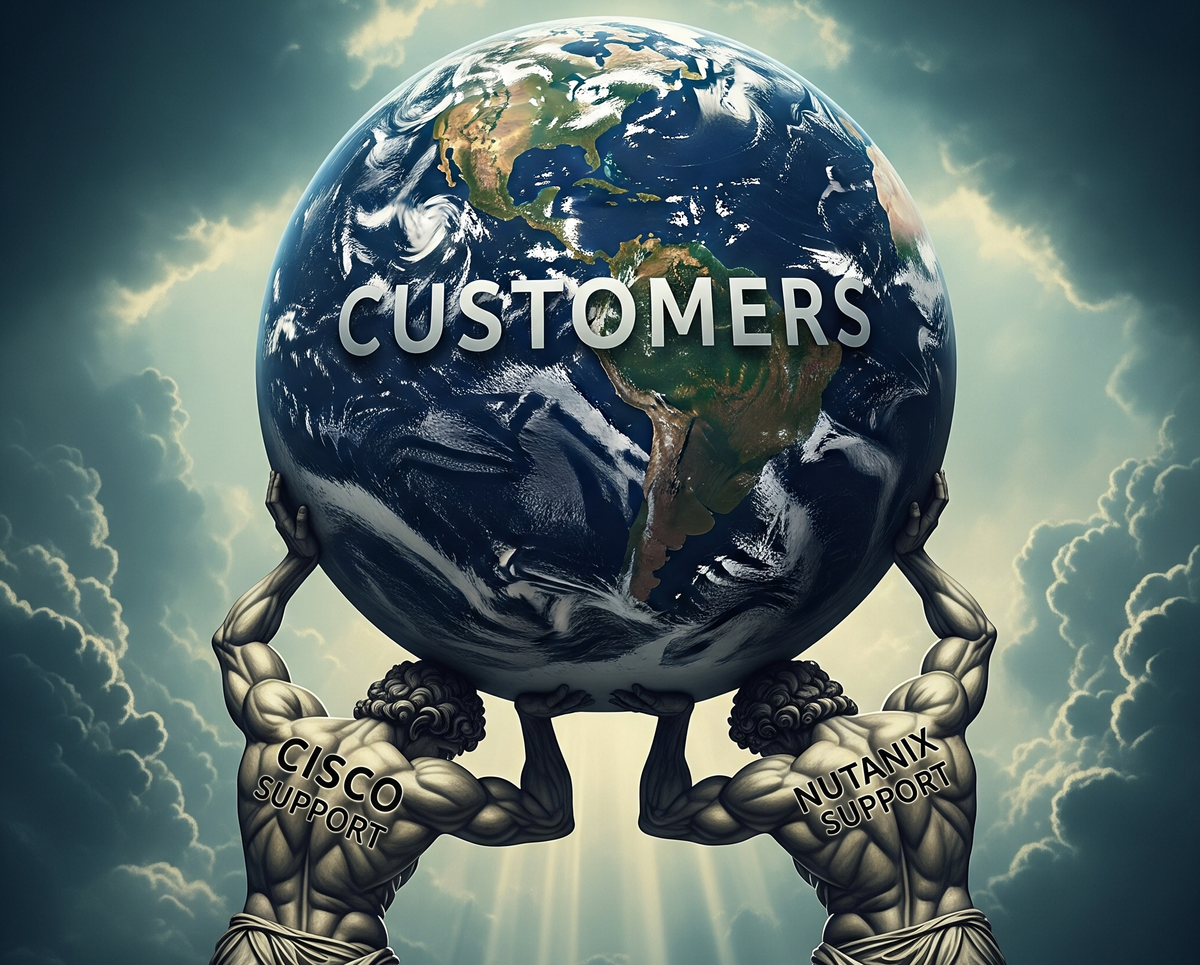The Three Pillars of the Partnership - Support
Addressing the second pillar of the Nutanix partnership is the differentiated support structure between Cisco and Nutanix.

Oh yeah - that image is totally AI generated and I love it as it truly depicts one of the big differentiators of the partnership. We addressed the engineering pillar in a previous post which is probably the biggest pillar that allows Cisco to differentiate its server technology with Nutanix software. We'll dig into the next big pillar in this post - Support.
Connected Support Organizations
We mentioned in a previous article that the public announcement of the partnership wasn't really when the work began between Cisco and Nutanix. One of these major efforts was architecting a support model that would provide a seamless customer experience while removing the he-said she-said finger pointing we often see with partnerships in the technology industry.
If you've ever had the pleasure to talk to any Nutanix sales team, it's almost a guarantee that a comment ... or 20, was made around their support organization and specifically, that their Net Promoter Score (NPS) was above 90. When you take the time to understand what an NPS is, it really should be the whole sales pitch to customers. So what is NPS?
Net Promoter Score or NPS is a metric often used to measure a customer's loyalty or satisfaction to a company based on their interactions. In the case of Nutanix, it is a measure their support organization and how satisfied customers are after having the unfortunate experience of having to call support. The scale of the NPS is -100 (on the low end) all the way up to +100 (the highest possible score, like bowling a 300). As mentioned above - Nutanix is above 90. They're very proud of this, and rightfully so. This is incredibly hard to achieve and is a testament to their investment in not only their support organization but the quality of software they release to customers.
We discussed in a previous article one of the requirements from Nutanix was to not get in the way of their support organization so they can maintain their high customer satisfaction. This was a challenge for not only the leaders of each company but also the engineers that needed to think of a way to make this work seamlessly. This integration between the support organizations was over 9 months in the making. So what's happening under the covers? Let's walk through a customer experience to explain this as clearly as possible.
When a customer purchases both Cisco hardware (or has existing hardware with a valid support contract) and Nutanix software through Cisco, they'll open a case through the Cisco Case Manager portal. Within the options found when opening the support case, one will fall along the lines of "I have a hardware problem" or "I have a Nutanix software problem." Once this selection is made is when all the magic starts.
Instant Case Routing
Depending on the option that a customer picks when selecting where they believe an issue may be happening is when a feature called "Instant Case Routing" kicks in. For example:
If a customer picks "I have a hardware problem" they immediately get routed to Cisco TAC (Technical Assistance Center) for support.
Conversely if a customer picks "I have a Nutanix software problem" they immediately get routed to the Nutanix support organization, completely bypassing Cisco TAC even though the support case is opened through Cisco Case Manager.

It doesn't make sense for Nutanix to triage and troubleshoot a Cisco hardware problem - they're not the expert in the hardware nor have access to all the logs and telemetry found in Intersight. On the same token, it doesn't make sense for Cisco TAC to troubleshoot Nutanix software related issues. Cisco is not the expert in the Nutanix software nor have access to internal troubleshooting articles. Having either support organizations take all initial support cases and attempt to troubleshoot issues that are unrelated to their respective areas of expertise only extends the time to resolution and often just leads to customer frustrations. The instant case routing feature fixes this problem.
But wait there's more! Call now and get an extra feature for free!
eBonded Support
Thought the instant case routing was a nice touch? The engineering teams went even further to integrate the support organizations to provide the best customer experience possible. Enter what is called "eBonded Support."
Take the example above where a customer opens a case and believes that the issue is with the Nutanix software. They immediately get routed to the Nutanix support organization and through some troubleshooting steps, the Nutanix support engineer determines that the issue is actually caused by the hardware and needs to transfer the customer to Cisco TAC. Traditionally speaking, what's a typical reaction to this? An eye roll, a heavy sigh, and the thought of "Great, here comes the finger pointing again and someone asking me if I've rebooted my PC three times" (by the way - if you get that reference, I applaud you).
Not So Fast My Friend!
The support organizations are integrated on the backend to further streamline the customer experience. When the customer initially opened the case and was routed to Nutanix through the "Instant Case Routing" feature - a shadow case was automatically opened with Cisco TAC where all case notes, email communications, and and relevant information from the Nutanix support engineer have already been synchronized to with Cisco TAC (see GIF above).
This allows Cisco to see what's already been done with the troubleshooting of the issue and resolve the customer problem much quicker without having to redo a bunch of tests to get to the root cause.
This eBonded support feature is a two-way street. The example above explains what happens when going from Nutanix to Cisco but the same feature and function also applies when going from Cisco to Nutanix.
You thought that was it? NOPE - keep reading!
Nutanix Insights
I'll keep this one brief but its still worth mentioning as the cherry on top. The Nutanix software does pro-active predictive drive failure analysis as it writes data blocks down to the disks. When the software notices that a drive is about to fail, it proactively takes the drive offline and marks it as failed in software. If a customer has the Nutanix Pulse call home feature, this notification is sent to something called Nutanix Insights.
The names here are really irrelevant but what's important to understand is when this is triggered by the Nutanix software, it doesn't necessarily mean that the drive actually went bad - therefore at the hardware level, the drive will still show as good.
To avoid confusion, the Cisco and Nutanix engineering teams further automated their integration by connecting this feature to Cisco TAC to automatically issue a drive return merchandise authorization (RMA) for a customer.
A Measure of Success
Taking all these things into consideration, Cisco and Nutanix developed a truly differentiated support experience for customers who choose to do business with Cisco with the development of the Instant Case Routing feature, the eBonded Support organizations, and automated drive RMA. You might ask yourself, is this actually working and making a difference? The answer is an emphatic yes!
Cisco and Nutanix hold regular engineering sync-up meetings and support is one of those discussion points. Cases between Cisco and Nutanix are actively tracked and measured against the NPS, which have met, and exceeded expectations from both companies.
Need more proof?
<exit stage right>